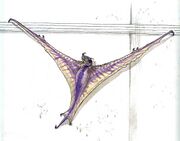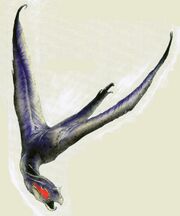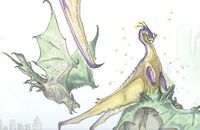Hawk-bat/Legends
Hawk-bats were predatory reptavians with a curved beak and leathery wings that could be found on urbanized worlds like Coruscant and Taris.
Overview
They were believed to be one of the few native Coruscanti species left in existence[2] (the Thrantcill being another). Both were feared and admired, although they were considered an elegant species. To get on a hawk-bat's bad side could be very dangerous. As a result, very few lived in captivity.
Sometimes seen riding the thermals rising from the bowels of the city, hawkbats on Coruscant are officially protected by law because they feed upon destructive silica parasites.[2]
Because of this, they became a symbol for many swoop gangs and pirates. The lightsaber form Ataru was named after the hawk-bat. One of the battalions which fought under the 101st Regiment during the Clone Wars was also known as the Hawkbat Battalion.

The wingspan of a hawk-bat averaged 1.5 meters. The wings consisted of a thin membrane stretched over a series of wing-bones. The membrane itself was studded with spiky growths. The hooked beak of a hawk-bat contained tiny teeth that could tear prey to shreds, which they found with a combination of keen, accurate eyesight and echolocation - best used in detecting camouflaged prey. Their vision detects an extremely wide spectrum, including ultraviolet, infrared, and beyond - for example, the dull green-gray of granite slug slime appears bright yellow to the hawkbat. When prey is spotted, hawk-bats stoop (air dive) for the target.
Flocks of hawk-bats would hunt and attack their prey as if they were one. Though they favored granite slugs and shadowmoth larvae, hawk-bats would feed on almost anything that moved (using their wing and tail membranes to scoop prey from vertical walls and catch the scooped prey with their hindlegs). Even large enemies could be taken down by a large flock of hawk-bats. Although a solitary hawk-bat could prove to be a significant threat, it was weaker when it was alone.
If one hawk-bat was disturbed, all of its companions would attack the aggravator at once. They usually traveled in large flocks through the pipes and lower levels of Coruscant, as well as the upper levels in contact with the sky. Every few months, they migrated on in both lower and upper levels, despite lack of seasons within the lower levels. Because of this, many scientists came to believe that hawk-bats evolved during the ancient times of Coruscant, making them one of the only known native species to survive Coruscant's urbanization. Hawk-bats hated the cold and usually stayed away from it. Many lived on power cables or in heated vents, hanging upside down from warm pipes below buildings.

Young of hawk-bats hatched from flexible-shelled, leathery eggs that conform to ledges and cornices. To keep their young safe during this critical period, hawk-bats would camouflage the brown and green eggs as best they could to make them appear to be mere rocks. And though the eggs may have looked abandoned by their parents, it was certain that one of them—most likely the mother—was keeping eye on the nest from a distance.
Hawk-bat mothers were extremely protective of their incubating young. Any rival species of predator who saw through the camouflage and threatened the eggs would quickly learn the full fury of a hawk-bat mother's wrath.

When they hatched from their eggs, young hawk-bats had scaly green skin and were precocial, meaning they were fully independent and able to hunt upon the day of hatching. Upon reaching maturity, the hawk-bat would anchor itself to something like a building crevice to shed its green skin and emerge with mature purplish-gray skin. It ate its old immature skin and then flew off to search for prey and a mate.[2]
Hawk-bat as delicacy
Sometime before or during the Imperial Period, Ortolan chef Handree Braman discovered that hawk-bat flesh was edible. He recommended cooking it at 1,000 degrees for no more than twenty minutes.
Many beings found hawk-bat meat delicious, and hawk-bat eggs were considered a delicacy. Emperor Palpatine had a private aviary of hawk-bats in the Imperial Palace on Coruscant, where he and guests could have hawk-bats at their leisure.
Hawk-bats managed to survive the Yuuzhan Vong War, and seem to have adapted to Coruscant's newly introduced biological components.
Appearances
Sources
- The Illustrated Star Wars Universe
- The Jedi Academy Sourcebook
- The Secrets of Star Wars: Shadows of the Empire
- The Essential Guide to Planets and Moons
 "Operation: Clodhopper" (original article link) on Wizards.com (content now obsolete; backup link)
"Operation: Clodhopper" (original article link) on Wizards.com (content now obsolete; backup link)- The Essential Guide to Alien Species
- The Wildlife of Star Wars: A Field Guide
 "Thyferra: Bacta Basics" (original article link) on Wizards.com (content now obsolete; backup link)
"Thyferra: Bacta Basics" (original article link) on Wizards.com (content now obsolete; backup link)- The Official Star Wars Fact File 97 (COR38, Coruscant - Animals)
- Star Wars Encyclopedia
- Star Wars: Attack of the Clones: The Illustrated Companion
- Star Wars: Empire at War: Prima Official Game Guide
- Star Wars: Empire at War: Forces of Corruption Expansion: Prima Official Game Guide
- The Complete Star Wars Encyclopedia
- The Jedi Path: A Manual for Students of the Force
